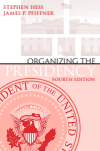Abstract
Examining how the White House worksor doesn'tbefore and after Trump
Donald Trump has reinvented the presidency, transforming it from a well-oiled if sometimes cumbersome institution into what has oftenseemed to be a one-man show. But even Trump's unorthodox presidency requires institutional support, from a constantly rotating White House staff and cabinet who have sought to carry outand sometimes resistthe president's direct orders and comply with his many tweets.
Nonetheless, the Trump White House still exhibits many features of its predecessors over the past eight decades. When Franklin D. Roosevelt was inaugurated, the White House staff numbered fewer than fifty people, and most federal department were lightly staffed as well. As the United States became a world power, the staff of the Executive Office increased twentyfold, and the staffing of federal agencies blossomed comparably.
In the fourth edition of Organizing the Presidency, a landmark volume examining the presidency as an institution, Stephen Hess and James P. Pfiffner argue that the successes and failures of presidents from Roosevelt through Trump have resulted in large part from how the president deployed and used White House staffers and other top officials responsible for carrying out Oval Office policy. Drawing on awealth of analysis and insight, Organizing the Presidency addresses best practices for managing a presidency that is itself a bureaucracy.
Schlagworte
Organizing the Presidency Oval Office Stephen Hess Presidential Staff White House Officials White House Staff U.S. Presidency U.S. Presidents Executive Office James P. Pfiffner James Pfiffner Federal Agencies- i–vi Preface i–vi
- 190–203 Donald J. Trump: 2017- 190–203
- 211–212 Acknowledgments 211–212
- 213–238 Notes 213–238
- 239–backcover1 Index 239–backcover1

